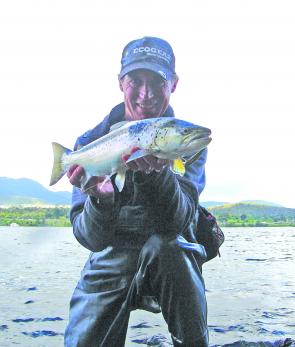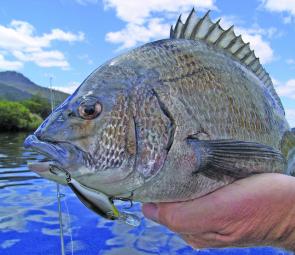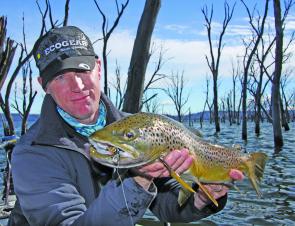September always seems to be that month when the trout season comes alive.
Whether you’re chasing sea trout on the Derwent or heading onto the plateau for some still water trout action, the warmer days regenerate the food chain and kick the whole system into gear. It’s been a chilly winter that will probably encourage Hobart anglers to stay on the Derwent searching for sea trout or perhaps hunting about the Derwent Valley streams.
As a warmer September rolls on we should see some improved action in the highlands at places like Lake Echo and Arthurs Lake. Otherwise the sea trout situation is normally worth investigating or should I say the bait distribution is what trout anglers should be concentrating on.
Patterns tend to emerge this month in regards to where and what Derwent trout are focused on. Those that do their homework will do well if they uncover a prolific bait and fish rich area. I found some great sea runner fishing last year inside several bays throughout the mid reaches of the Derwent. Most anglers would be looking to find sea trout in the upper river at this time.
The fish I found were more intent on eating larger prey in the shallows at high tide rather than the smaller whitebait that arrives en masse. Sea trout can be tricky to locate, so having a few hot spot variations on hand can be a real day saver at times.
I plan to work on the highly weeded areas around Granton and Bridgewater this season as I know there are plenty of good fish in these difficult to fish sections of the river. I had some success last year targeting the more distinct channels that feed a few deep holes or gutters.
Timing is essential when fishing the worst of the weeded flats and a small flat-bottomed vessel is also a big help. My mistake in seasons past was to work my way into these spots at high tide, not knowing exactly where the escape route was. The penny dropped recently when I spoke to another angler that always accesses these channels at low tide marking the way in with stakes. This made perfect sense and made me think about why I hadn’t thought of that approach as I do the same low tide access trick a many other shallow water locations. This example shows the importance of talking to other like minded anglers as little bits of info like this can help to unlock another what was a no go area in the past.
The Jordan River in September is an excellent spot within the Derwent system to target sea trout. Most shores along the mid-reaches are worth working over as well but the more prominent points and shallow zones with inflows can be better at times.
Upstream, the vicinity of the Bridgewater Bridge is a holding area or a stop over point for many sea trout and is always worth some fishing time.
Further upstream the area around the Lime Kilns has always been a good start point for many a day’s fishing. Defined grass edges dominate the riverbanks from here on up and suits both lure and fly anglers alike. Look for creek entrances and structure that punctuates the often quite featureless banks. As always, lightly rigged 3” minnow type soft plastics are the go for an all-round lure but hardbodied minnows can be very good fish takers.
Further stockings during winter should bump up the action at several trout waters this season. Inland fisheries have continued to concentrate on Lake Dulverton and have attempted to enhance the fishing at Brady’s lake with more stockings over the closed season. Remember to check your angling code for some small changes that have been imposed at certain waters.
There have been some good breaming days amongst many made almost unfishable by very cold weather and fresh water flushing down the Derwent system. Bream seem to have been forced into schools over the last month or two as they escape cold water by retreating into the backs of bays. Anglers that have discovered these schools have had some great sessions using soft plastics and slow lift and drop retrieves.
Winter this year was very cold and only the dedicated seemed to get out and into the bream. But, some have done well which shows there is always an angle on Derwent breaming in some shape or form.
September should see the bream start to move toward the normal spawn zones. Initially, the bream tend to be very intent on breeding and not that inclined to start eating. But when they do bite, the sessions can be frenetic.
Bream spawn over many day or weeks and catching them at these times is fine as long as you release the fish where you take them. I’m sure there are few anglers out there that would want to keep any fish that’s half way through spawning. I live in hope that some form of legislation in the form of spawning bream protection will emerge from the powers entrusted with this iconic Tasmanian fishery. How good would that be!
Winter garfish have been the focus for bay fishers familiar with the basic anchor and berley trail set up that’s needed to get a session started. Light spin rods loaded with 6lb mainline completed with a small float with a size 8 or 10 long shank hook will get you started. Use small strips of calamari, peeled school prawn or my favourite, white bread dough.
A building tide is a good idea as well if you’re looking to have a go at the gar. Add some split shot above the hook in order to keep the short dropper below the float as straight as possible. Gars are a fine table fish as the sweet flesh comes away from the frame with ease once cooked.
Whiting are also a good target until things warm up and while looking at light gear fishing. A soft action spin rod loaded with 8-10lb line combined with a small bomb sinker and a single short (20cm) dropper rig. Space the dropper about 50cm above the sinker and tie on a size 8 long shank hook. Baits can be calamari, but using a bait pump to find some fresh local bait is something we should do a lot more of and will work even better. The 3-6m zone in Frederick Henry Bay adjacent to the Hobart airport is a known local whiting area and well worth a try.
Don’t forget the calamari, as catches over the last month have improved significantly and the action will only hot up as spring rolls on. Get into your local store and check out the array of new ‘egi’ gear on offer.
You’ll be surprised how far squid angling has come in recent times and how effective quality gear is when you apply it to great squid grounds that we have around Hobart. Great fun fishing and a great feed at the end of the day.
Reads: 3311
September sea trout action is very popular on the Derwent.

Getting hardbodied lures down deep is the keep in September.

Fast and furious action can result once you hit the honey hole.

Lake Echo always throws up some good early season lure fishing amongst the trees.




